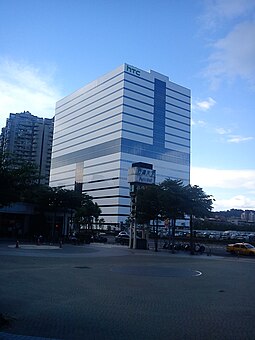 Nokia is a Finnish multinational communications and information technology company. Nokia is headquartered in Espoo,Uusimaa, in the greater Helsinki metropolitan area.[1] In 2014, Nokia employed 61,656 people across 120 countries, conducts sales in more than 150 countries and reported annual revenues of around €12.73 billion. Nokia is a public limited-liability company listed on the Helsinki Stock Exchange and New York Stock Exchange. It is the world's 274th-largest company measured by 2013 revenues according to the Fortune Global 500.
Nokia is a Finnish multinational communications and information technology company. Nokia is headquartered in Espoo,Uusimaa, in the greater Helsinki metropolitan area.[1] In 2014, Nokia employed 61,656 people across 120 countries, conducts sales in more than 150 countries and reported annual revenues of around €12.73 billion. Nokia is a public limited-liability company listed on the Helsinki Stock Exchange and New York Stock Exchange. It is the world's 274th-largest company measured by 2013 revenues according to the Fortune Global 500.
The company currently focuses on large-scale telecommunications infrastructures, technology development and licensing, and online mapping services. Nokia is also a significant contributor to the mobile telephony industry, having assisted in development of the GSM and LTE standards, and was, for a period, the largest vendor of mobile phones in the world. Nokia's dominance also extended into the smartphone industry through its Symbian platform, but it was soon overshadowed by the growing dominance of Apple's iPhone line and Android devices. Nokia eventually entered into a pact with Microsoft in 2011 to exclusively use its Windows Phone platform on future smartphones.
In September 2013, Microsoft announced that it would acquire Nokia's mobile phone business as part of an overall deal totaling €5.44 billion (US$7.17 billion). Stephen Elop, Nokia's former CEO, and several other executives joined the new Microsoft Mobile subsidiary of Microsoft as part of the deal, which was completed on 25 April 2014. In November 2014, Nokia began to license product designs and technologies to third-party manufacturers, to enable a continued presence for the Nokia brand in the consumer electronics hardware market.
History:
On 15 April 2015, Nokia announced that it would acquire the French telecommunications equipment company Alcatel-Lucent for €15.6 billion.The predecessors of the modern Nokia were the Nokia Company (Nokia Ab),Finnish Rubber Works Ltd (Suomen Gummitehdas Oy) and Finnish Cable Works Ltd (Suomen Kaapelitehdas Oy). The company's name came from the Nokia town and the Nokianvirta river.
Nokia Company's history started in 1865 when mining engineer Fredrik Idestam established a ground wood pulp mill on the banks of the Tammerkoski rapids in the town of Tampere, in southwestern Finland (then, part of the Russian Empire). In 1868, Idestam built a second mill near the town of Nokia, fifteen kilometers (nine miles) west of Tampere, by the Nokianvirta river, which had better hydropower resources. In 1871, Idestam, with the help of close friend and statesman Leo Mechelin, renamed and transformed his firm into a share company, thereby founding Nokia Ab.
Eduard Polón (1861–1930), was a Finnish business leader. In 1898, Polón founded Finnish Rubber Works (Suomen Gummitehdas Oy), manufacturer ofgaloshes and other rubber products, which later became Nokia's rubber business. At the beginning of the 20th century, Finnish Rubber Works established its factories near the town of Nokia and began using its name as its product brand.
Towards the end of the 19th century, Mechelin sought to expand into the electricity business, but his aspiration was initially thwarted by Idestam's opposition. However, Idestam's retirement in 1896 allowed Mechelin to become the company's chairman (from 1898 until 1914), and he subsequently convinced shareholders. In 1902, Nokia added electricity generation to its business activities.
In 1912, Arvid Wickström founded Finnish Cable Works (Suomen Kaapelitehdas Oy), producer of telephone, telegraph and electrical cables and the foundation of Nokia's cable and electronics businesses. At the end of the 1910s, shortly after World War I, the Company was nearing bankruptcy. To ensure the continuation of electricity supply from Nokia's generators, Finnish Rubber Works acquired the business of the insolvent company.In 1922, Finnish Rubber Works acquired Finnish Cable Works. In 1937, Verner Weckman, a wrestler and Finland's first Olympic Gold medalist, became president of Finnish Cable Works, after 16 years as its technical director.After World War II, Finnish Cable Works supplied cables to the Soviet Union as part of war reparations. This gave the company a foothold for later trade.
Although these three companies—Nokia Ab, Suomen Gummitehdas, Suomen Kaapelitehdas—were not formally merged, as the law did not allow it at the time, Polón continued to create a successful conglomerate that later became Nokia PLC. Polòn was the chairman, managing director, and the largest owner of the group for 30 years.
The three companies, jointly owned since 1922, were merged to form a new industrial conglomerate, Nokia Corporation, in 1967.The new company was involved in many industries, producing at various times paper products, car and bicycle tires, footwear (including rubber boots), communications cables, televisions and other consumer electronics, personal computers, electricity generation machinery, robotics, capacitors, Military technology and equipment (such as the SANLA M/90 device and the M61 gas mask for the Finnish Army), plastics, aluminum and chemicals. Each business unit had its own director who reported to the first Nokia Corporation President, Björn Westerlund. As the president of the Finnish Cable Works, he had been responsible for setting up the company's first electronics department in 1960, sowing the seeds of Nokia's future in telecommunications.

 Motorola, Inc.
Motorola, Inc.  HTC Corporation
HTC Corporation Windows Phone
Windows Phone LG Corporation
LG Corporation